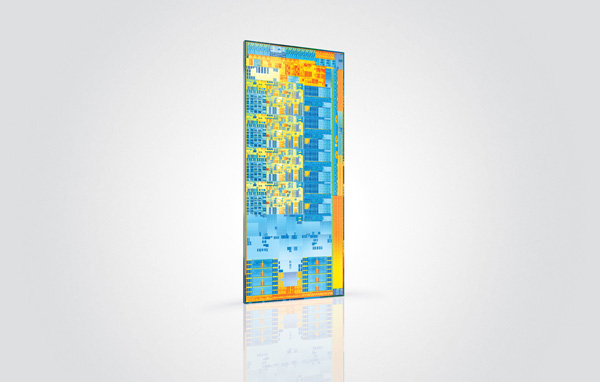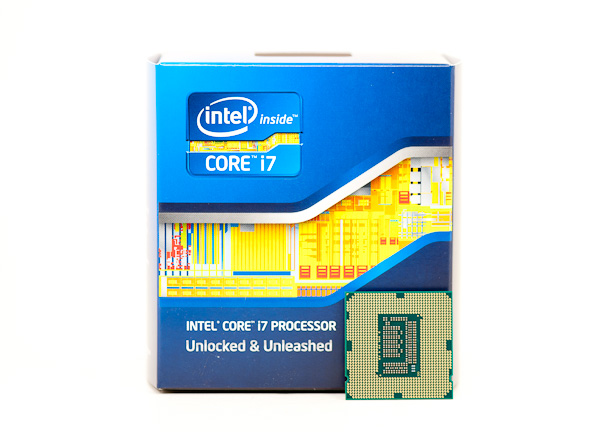The Intel Ivy Bridge (Core i7 3770K) Review
by Anand Lal Shimpi & Ryan Smith on April 23, 2012 12:03 PM EST- Posted in
- CPUs
- Intel
- Ivy Bridge
Final Words
Reviewing a tick in Intel's cadence is always difficult. After Conroe if we didn't see a 40% jump in a generation we were disappointed. And honestly, after Sandy Bridge I felt it would be quite similar. Luckily for Intel, Ivy Bridge is quite possibly the strongest tick it has ever put forth.
Ivy Bridge is unique in that it gives us the mild CPU bump but combines it with a very significant increase in GPU performance. The latter may not matter to many desktop users, but in the mobile space it's quite significant. Ultimately that's what gives Ivy Bridge it's appeal. If you're already on Intel's latest and greatest, you won't appreciate Ivy as an upgrade but you may appreciate for the role it plays in the industry—as the first 22nm CPU from Intel and as a bridge to Haswell. If you missed last year's upgrade, it'll be Ivy's performance and lower TDP that will win you over instead.
Intel has done its best to make this tick more interesting than most. Ivy Bridge is being used as the introduction vehicle to Intel's 22nm process. In turn you get a cooler running CPU than Sandy Bridge (on the order of 20—30W under load), but you do give up a couple hundred MHz on the overclocking side. While I had no issues getting my 3770K up to 4.6GHz on the stock cooler, Sandy Bridge will likely be the better overclocker for most.
With Ivy Bridge and its 7-series chipset we finally get USB 3.0 support. In another month or so we'll also get Thunderbolt support (although you'll have to hold off on buying a 7-series motherboard until then if you want it). This platform is turning out to be everything Sandy Bridge should have been.
Ivy's GPU performance is, once again, a step in the right direction. While Sandy Bridge could play modern games at the absolute lowest quality settings, at low resolutions, Ivy lets us play at medium quality settings in most games. You're still going to be limited to 1366 x 768 in many situations, but things will look significantly better.
The sub-$80 GPU market continues to be in danger as we're finally able to get not-horrible graphics with nearly every Intel CPU sold. Intel still has a long way to go however. The GPUs we're comparing to are lackluster at best. While it's admirable that Intel has pulled itself out of the graphics rut that it was stuck in for the past decade, more progress is needed. Ivy's die size alone tells us that Intel could have given us more this generation, and I'm disappointed that we didn't get it. At some point Intel is going to have to be more aggressive with spending silicon real estate if it really wants to be taken seriously as a GPU company.
Similarly disappointing for everyone who isn't Intel, it's been more than a year after Sandy Bridge's launch and none of the GPU vendors have been able to put forth a better solution than Quick Sync. If you're constantly transcoding movies to get them onto your smartphone or tablet, you need Ivy Bridge. In less than 7 minutes, and with no impact to CPU usage, I was able to transcode a complete 130 minute 1080p video to an iPad friendly format—that's over 15x real time.
While it's not enough to tempt existing Sandy Bridge owners, if you missed the upgrade last year then Ivy Bridge is solid ground to walk on. It's still the best performing client x86 architecture on the planet and a little to a lot better than its predecessor depending on how much you use the on-die GPU.
Additional Reading
Intel's Ivy Bridge Architecture Exposed
Mobile Ivy Bridge Review
Undervolting & Overclocking on Ivy Bridge
Intel's Ivy Bridge: An HTPC Perspective












173 Comments
View All Comments
JarredWalton - Tuesday, April 24, 2012 - link
I don't think it's a mystery. It's straight fact: "One problem Intel does currently struggle with is game developers specifically targeting Intel graphics and treating the GPU as a lower class citizen."It IS a problem, and it's one INTEL has to deal with. They need more advocates with game developers, they need to make better drivers, and they need to make faster hardware. We know exactly why this has happened: Intel IGP failed to run for so long that a lot of developers gave up and just blacklisted Intel. Now, Intel is actually capable of running most games, and so long as they aren't explicitly blacklisted things should be okay.
In truth, the only title I can think of from recent history where Intel could theoretically work but was blacklisted by the game developer is Fallout 3. Even today, if you want to run FO3 on Intel IGP (HD 2000/3000/4000), you need to download a hacked DLL that will identify your Intel GPU as an NVIDIA GT 9800 or something.
And really, there's no need to blacklist by game developers, because you can't predict the future. FO3 is the perfect example: it runs okay on HD 3000 and plenty fast on HD 4000, but the shortsighted developers locked out Intel for all time. It's better to pop up a warning like some games do: "Warning: we don't recognize your driver and the game may not run properly." Blacklisting is almost more of a political statement IMO.
craziplaya21 - Monday, April 23, 2012 - link
I might be blind or something but did you guys not do a comparison between an original bluray IQ vs an encoded 1080p IQ by quicksync??toyotabedzrock - Monday, April 23, 2012 - link
Why is Intel disabling this on the K parts? And why disable vPro?jwcalla - Monday, April 23, 2012 - link
First, a diversion: "I was able to transcode a complete 130 minute 1080p video to an iPad friendly format..." Just kill me. Somebody please. Why do consumers put up with this crap? Even my ancient Galaxy S has better media playback support.It's the same story with my HP TouchPad: MP4 container or GTFO. Who can stand to re-encode their media libraries or has the patience to deal with DLNA slingers when the hardware is perfectly capable of curb-stomping any container / codec you could even conceive? Just get an Android tablet if this is the crap they force on you. Or, in the TouchPad case, wipe it and install ICS.
As for the article... did I totally misunderstand the page about power consumption? I got the impression that idle power is relatively unchanged. I must be misreading that. Or maybe the lower-end chips will show a stark improvement. Otherwise I totally miss the point of IVB.
I'm beginning to lose confidence in Intel, at least in terms of innovation. These tick-tock improvements are basically minor pushes in the same boring direction. From an enthusiasts' perspective, the stuff going into ARM SoCs is so much more interesting. Intel makes great high-end CPUs but it seems that these are becoming less important when looking at the consumer market as a whole.
Anand Lal Shimpi - Monday, April 23, 2012 - link
Idle power didn't really go down because at idle nearly everything is power gated to begin with. Any improvements in leakage current don't help if the transistors aren't leaking to begin with :)Your ARM sentiments are spot on for a huge portion of the market however. Let's see what Haswell brings...
Take care,
Anand
thomas-hrb - Monday, April 23, 2012 - link
I disagree with the testing methodology for the World of Warcraft test. Firstly no gamer of any game buys hardware so they can go to the most isolated areas in a game. Also the percentage of who can pay for one of these CPU's who would be playing at 1650x1050, would be pretty small.I've been playing WoW for a number of years and I don't care about 60fps+ because my monitor won't display it anyway. I care about minimum fps and average fps. nVidia's new adaptive vsync is a great innovation, but I am sure there are other tests that while not as controlled and repeatable is a much indicative of real world performance (the actual reason behind purchasing decisions).
One possible testing methodology you could look into is to take a character into one of the topend 25man raids. There are 10 classes in WoW and my experience is that a 25man raid will show up every single possible spell/ability and effect that the game has to offer in fairly repeatable patterns.
I agree that it is not the most scientific approach but I put more stock in a friend saying "go buy this cpu/gpu you can do all the raids and video capture and you get no lag" than you telling me that this cpu will give me 100+ fps in the middle of nowhere. There is a fine line between efficient and effective. I am just hoping that you can dial down the efficiency and come up with a testing methodology that actually produces a metric I can use in my purchasing decisions. After all that is one of the core reasons most people read reviews at all.
redisnidma - Monday, April 23, 2012 - link
Expect Anand's Trinity review to be heavily biased with lots of AMD bashing.This site is so predictable...
Nfarce - Monday, April 23, 2012 - link
Oh boy. Another delusional red label fangirl. Maybe when AMD gets their s**t together Anandtech will have something positive to review in comparison to the Intel offerings at the moment. Bulldozer bulldozed right off a cliff. And don't get me wrong: I WANT AMD to whip out some butt-kicking CPUs to keep the competition strong. But right now, Intel is not getting complacent and keep stepping their game up when the competition isn't even on the same playing court. But that's just for now. If AMD continues to falter, Intel may not be as motivated to stay ahead and spend so much R&D in the future. After all, why put the latest F1 car on the track when the competition can only bring a NASCAR car to every track?Reikon - Monday, April 23, 2012 - link
Temperature is in the overclocking article.http://www.anandtech.com/show/5763/undervolting-an...
rickthestik - Monday, April 23, 2012 - link
An upgrade for me makes sense as my current cpu is an Intel Core 2 Quad and the new i7-3770K will be a pretty significant upgrade...2.34Ghz to 3.5Ghz and the heaps of additonal tech to go with it.I could see a fair number of Sandy Bridge owners holding off for Haswell, though for me this jump is pretty big and I'm looking forward to seeing what the i7-3770K can do with the Z77 motherboards and a shiny new PCI 3.0 GPU.